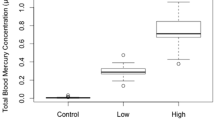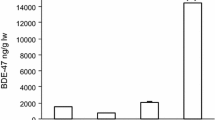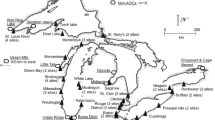Abstract
Developmental exposure of wildlife to anthropogenic contaminants can have long-term effects that are difficult to assess in field monitoring studies, and may not be evident in laboratory studies that lack ecological components. The objective of this study was to assess the long-term effects of early exposure to contaminants under ecological conditions in a model passerine species, the European starling (Sturnus vulgaris). We selected 2,2′,4,4′,5-pentabromodiphenyl ether (BDE-99) as a representative contaminant, as it is one of the major constituents of the commercial penta-BDE flame retardant mixture, and has been reported in avian egg and tissue samples worldwide. We developed a novel approach to assess the developmental toxicity of BDE-99 in starlings by combining aspects of laboratory and field studies. We dosed free-living nestlings living in natural broods in the field with environmentally relevant concentrations of BDE-99 (0–173.8 ng/g bw/day) for the duration of the nesting cycle. To simulate monitoring of long-term effects we brought birds into captivity just prior to fledging and used photoperiod manipulations to induce reproductive development. We assessed a range of physiological and development measures such as hematocrit, oxidative stress, thyroid hormones, neuroanatomy, growth, molt rate, bill color, and testes development. We found some evidence of thyroid hormone disruption, but there were no effects on any other measures of physiology or development. The European starling could serve as a valuable model species for assessing early exposure and long-term effects of anthropogenic contaminants in terrestrial wildlife using this combined field/laboratory approach.



Similar content being viewed by others
References
Abdollahi M, Ranjbar A, Shadnia S, Nikfar S, Rezaie A (2004) Pesticides and oxidative stress: a review. Med Sci Monitor 10:RA141–RA147
Albina ML, Alonso V, Linares V, Belles M, Sirvent JJ, Domingo JL, Sanchez DJ (2010) Effects of exposure to BDE-99 on oxidative status of liver and kidney in adult rats. Toxicology 271:51–56. doi:10.1016/j.tox.2010.03.006
Alonso V, Linares V, Belles M, Albina ML, Pujol A, Domingo JL, Sanchez DJ (2010) Effects of BDE-99 on hormone homeostasis and biochemical parameters in adult male rats. Food Chem Toxicol 48:2206–2211. doi:10.1016/j.fct.2010.05.048
Ankley GT, Bennett RS, Erickson RJ, Hoff DJ, Hornung MW, Johnson RD, Mount DR, Nichols JW, Russom CL, Schmieder PK, Serrrano JA, Tietge JE, Villeneuve DL (2010) Adverse outcome pathways: a conceptual framework to support ecotoxicology research and risk assessment. Environ Toxicol Chem 29:730–741. doi:10.1002/etc.34
Arenal CA, Halbrook RS, Woodruff M (2004) European starling (Sturnus vulgaris): avian model and monitor of polychlorinated biphenyl contamination at a superfund site in southern Illinois, USA. Environ Toxicol Chem 23:93–104
Ball GF, Riters LV, Balthazart J (2002) Neuroendocrinology of song behavior and avian brain plasticity: multiple sites of action of sex steroid hormones. Front Neuroendocrinol 23:137–178. doi:10.1006/frne.2002.0230
Bardo L, Bird DM (2009) The use of captive American kestrels (Falco sparverius) as wildlife models: a review. J Raptor Res 43:345–364. doi:10.3356/jrr-09-03.1
Belles M, Alonso V, Linares V, Albina ML, Sirvent JJ, Domingo JL, Sanchez DJ (2010) Behavioral effects and oxidative status in brain regions of adult rats exposed to BDE-99. Toxicol Lett 194:1–7. doi:10.1016/j.toxlet.2010.01.010
Bottjer SW, Glaessner SL, Arnold AP (1985) Ontogeny of brain nuclei controlling song learning and behavior in zebra finches. J Neurosci 5:1556–1562
Cesh LS, Elliott KH, Quade S, McKinney MA, Maisoneuve F, Garcelon DK, Sandau CD, Letcher RJ, Williams TD, Elliott JE (2010) Polyhalogenated aromatic hydrocarbons and metabolites: relation to circulating thyroid hormone and retinol in nestling bald eagles (Haliaeetus leucocephalus). Environ Toxicol Chem 29:1301–1310. doi:10.1002/etc.165
Chang L, Munro SLA, Richardson SJ, Schreiber G (1999) Evolution of thyroid hormone binding by transthyretins in birds and mammals. Eur J Biochem 259:534–542. doi:10.1046/j.1432-1327.1999.00076.x
Chen D, Hale RC (2010) A global review of polybrominated diphenyl ether flame retardant contamination in birds. Environ Int 36:800–811. doi:10.1016/j.envint.2010.05.013
Chen D, Martin P, Burgess NM, Champoux L, Elliott JE, Forsyth DJ, Idrissi A, Letcher RJ (2013) European starlings (Sturnus vulgaris) suggest that landfills are an important source of bioaccumulative flame retardants to Canadian terrestrial ecosystems. Environ Sci Technol 47:12238–12247. doi:10.1021/es403383e
Dawson A (2003) A comparison of the annual cycles in testicular size and moult in captive European starlings Sturnus vulgaris during their first and second years. J Avian Biol 34:119–123. doi:10.1034/j.1600-048X.2003.03055.x
Dawson A (2006) The role of prolactin in the regulation of molt. J Ornithol 147:58
Dawson A, Goldsmith AR (1983) Plasma prolactin and gonadotropins during gonadal development and the onset of photorefractoriness in male and female starlings (Sturnus vulgaris) on artificial photoperiods. J Endocrinol 97:253–260. doi:10.1677/joe.0.0970253
Eens M, Jaspers VLB, Van den Steen E, Bateson M, Carere C, Clergeau P, Costantini D, Dolenec Z, Elliott JE, Flux J, Gwinner H, Halbrook RS, Heeb P, Mazgajski TD, Moksnes A, Polo V, Soler JJ, Sinclair R, Veiga J, Williams TD, Covaci A, Pinxten R (2013) Can starling eggs be useful as a biomonitoring tool to study organohalogenated contaminants on a worldwide scale? Environ Int 51:141–149. doi:10.1016/j.envint.2012.11.003
Eng ML, Elliott JE, MacDougall-Shackleton SA, Letcher RJ, Williams TD (2012) Early exposure to 2,2′,4,4′,5-pentabromodiphenyl ether (BDE-99) affects mating behavior of zebra finches. Toxicol Sci 127:269–276. doi:10.1093/toxsci/kfs076
Eng ML, Williams TD, Elliott JE (2013) Developmental exposure to a brominated flame retardant: an assessment of effects on physiology, growth, and reproduction in a songbird, the zebra finch. Environ Pollut 178:343–349. doi:10.1016/j.envpol.2013.03.037
Environment Canada (2011) Environmental monitoring and surveillance in support of the Chemicals Management Plan. http://www.ec.gc.ca/Publications/default.asp?lang=En&xml=F48952A0-3F54-4D76-BAA6-EA6CF5529590. Accessed 28 May 2013
Erel O (2004) A novel automated direct measurement method for total antioxidant capacity using a new generation, more stable ABTS radical cation. Clin Biochem 37:277–285. doi:10.1016/j.clinbiochem.2003.11.1015
Erel O (2005) A new automated colorimetric method for measuring total oxidant status. Clin Biochem 38:1103–1111. doi:10.1016/j.clinbiochem.2005.08.008
Fernie KJ, Shutt JL, Mayne G, Hoffman D, Letcher RJ, Drouillard KG, Ritchie IJ (2005) Exposure to polybrominated diphenyl ethers (PBDEs): changes in thyroid, vitamin A, glutathione homeostasis, and oxidative stress in American kestrels (Falco sparverius). Toxicol Sci 88:375–383
Finkel T, Holbrook NJ (2000) Oxidants, oxidative stress and the biology of ageing. Nature 408:239–247. doi:10.1038/35041687
Glomski CA, Pica A (2011) The avian erythrocyte: its phylogenetic odyssey. Science Publishers, New York
Hakk H, Larsen G, Klasson-Wehler E (2002) Tissue disposition, excretion and metabolism of 2,2′,4,4′,5-pentabromodiphenyl ether (BDE-99) in the male Sprague-Dawley rat. Xenobiotica 32:369–382
Halliwell B (2007) Biochemistry of oxidative stress. Biochem Soc Trans 35:1147–1150
Handy RD, Depledge MH (1999) Physiological responses: their measurement and use as environmental biomarkers in ecotoxicology. Ecotoxicology 8:329–349. doi:10.1023/a:1008930404461
Henny CJ, Kaiser JL, Grove RA, Johnson BL, Letcher RJ (2009) Polybrominated diphenyl ether flame retardants in eggs may reduce reproductive success of ospreys in Oregon and Washington, USA. Ecotoxicology 18:802–813. doi:10.1007/s10646-009-0323-4
Hites RA (2004) Polybrominated diphenyl ethers in the environment and in people: a meta-analysis of concentrations. Environ Sci Technol 38:945–956
Hoogesteijn AL, Kollias GV, Quimby FW, De Caprio AP, Winkler DW, DeVoogd TJ (2008) Development of a brain nucleus involved in song production in zebra finches (Taeniopygia guttata) is disrupted by Aroclor 1248. Environ Toxicol Chem 27:2071–2075
Hutchinson TH, Solbe J, Kloepper-Sams PJ (1998) Analysis of the ECETOC aquatic toxicity (EAT) database—III—comparative toxicity of chemical substances to different life stages of aquatic organisms. Chemosphere 36:129–142. doi:10.1016/s0045-6535(97)10025-x
Iwaniuk AN, Koperski DT, Cheng KM, Elliott JE, Smith LK, Wilson LK, Wylie DRW (2006) The effects of environmental exposure to DDT on the brain of a songbird: changes in structures associated with mating and song. Behav Brain Res 173:1–10
Kessel B (1957) A study of the breeding biology of the European starling (Sturnus vulgaris L.) in North America. Am Midl Nat 58:257–331. doi:10.2307/2422615
Kuriyama SN, Wanner A, Fidalgo-Neto AA, Talsness CE, Koerner W, Chahoud I (2007) Developmental exposure to low-dose PBDE-99: tissue distribution and thyroid hormone levels. Toxicology 242:80–90
Lambrechts MM, Perret P, Maistre M, Blondel J (1999) Do experiments with captive non-domesticated animals make sense without population field studies? A case study with blue tits’ breeding time. Proc R Soc B 266:1311–1315
Leijs MM, Koppe JG, Olie K, van Aalderen WMC, de Voogt P, ten Tusscher GW (2009) Effects of dioxins, PCBs, and PBDEs on immunology and hematology in adolescents. Environ Sci Technol 43:7946–7951. doi:10.1021/es901480f
Lilienthal H, Hack A, Roth-Harer A, Grande SW, Talsness CE (2006) Effects of developmental exposure to 2,2′,4,4′,5-pentabromodiphenyl ether (PBDE-99) on sex steroids, sexual development, and sexually dimorphic behavior in rats. Environ Health Perspect 114:194–201
Livingstone DR (2001) Contaminant-stimulated reactive oxygen species production and oxidative damage in aquatic organisms. Mar Pollut Bull 42:656–666. doi:10.1016/s0025-326x(01)00060-1
Love OP, Chin EH, Wynne-Edwards KE, Williams TD (2005) Stress hormones: a link between maternal condition and sex-biased reproductive investment. Am Nat 166:751–766. doi:10.1086/497440
Markman S, Leitner S, Catchpole C, Barnsley S, Muller CT, Pascoe D, Buchanan KL (2008) Pollutants increase song complexity and the volume of the brain area HVC in a songbird. PLoS ONE 3:6. doi:10.1371/journal.pone.0001674
Marteinson SC, Kimmins S, Bird DM, Shutt JL, Letcher RJ, Ritchie IJ, Fernie KJ (2011) Embryonic exposure to the polybrominated diphenyl ether mixture, DE-71, affects testes and circulating testosterone concentrations in adult American kestrels (Falco sparverius). Toxicol Sci 121:168–176. doi:10.1093/toxsci/kfr027
Martin PA, Mayne GJ, Bursian SJ, Tomy G, Palace V, Pekarik C, Smits J (2007) Immunotoxicity of the commercial polybrominated diphenyl ether mixture DE-71 in ranch mink (Mustela vison). Environ Toxicol Chem 26:988–997. doi:10.1897/06-246r.1
McNabb FMA (2007) The hypothalamic–pituitary–thyroid (HPT) axis in birds and its role in bird development and reproduction. Crit Rev Toxicol 37:163–193. doi:10.1080/10408440601123552
McNaughton FJ, Dawson A, Goldsmith AR (1992) Juvenile photorefractoriness in starlings, Sturnus vulgaris, is not caused by long days after hatching. Proc R Soc B 248:123–128. doi:10.1098/rspb.1992.0051
Miller MD, Crofton KM, Rice DC, Zoeller RT (2009) Thyroid-disrupting chemicals: interpreting upstream biomarkers of adverse outcomes. Environ Health Perspect 117:1033–1041. doi:10.1289/ehp.0800247
Mooney R, Rao M (1994) Waiting periods versus early innervation—the development of axonal connections in the zebra finch song system. J Neurosci 14:6532–6543
Murvoll KM, Jenssen BM, Skaare JU (2005) Effects of pentabrominated diphenyl ether (PBDE-99) on vitamin status in domestic duck (Anas platyrhynchos) hatchlings. J Toxicol Environ Health 68:515–533
Neale JCC, Gulland FMD, Schmelzer KR, Harvey JT, Berg EA, Allen SG, Greig DJ, Grigg EK, Tjeerdema RS (2005) Contaminant loads and hematological correlates in the harbor seal (Phoca vitulina) of San Francisco Bay, California. J Toxicol Environ Health 68:617–633. doi:10.1080/15287390590921748
Newton I (1966) Moult of the bullfinch Pyrrhula pyrrhula. Ibis 108:41–67. doi:10.1111/j.1474-919X.1966.tb07251.x
Payne RB (1972) Mechanisms and control of molt. In: Farner DS, King JR (eds) Avian biology, vol II. Academic Press, New York, pp 103–155
Peterson RE, Theobald HM, Kimmel GL (1993) Developmental and reproductive toxicity of dioxins and related compounds—cross-species comparisons. Crit Rev Toxicol 23:283–335
Plikaytis BD, Holder PF, Pais LB, Maslanka SE, Gheesling LL, Carlone GM (1994) Determination of parallelism and nonparallelism in bioassay dilution curves. J Clin Microbiol 32:2441–2447
Schulte-Hostedde AI, Zinner B, Millar JS, Hickling GJ (2005) Restitution of mass-size residuals: validating body condition indices. Ecology 86:155–163
Spalding MG, Frederick PC, McGill HC, Bouton SN, Richey LJ, Schumacher IM, Blackmore CG, Harrison J (2000) Histologic, neurologic, and immunologic effects of methylmercury in captive great egrets. J Wildl Dis 36:423–435
Stohs SJ, Bagchi D (1995) Oxidative mechanisms in the toxicity of metal-ions. Free Radical Biol Med 18:321–336. doi:10.1016/0891-5849(94)00159-h
Tagliaferri S, Caglieri A, Goldoni M, Pinelli S, Alinnovi R, Poli D, Pellacani C, Giordano G, Mutti A, Costa LG (2010) Low concentrations of the brominated flame retardants BDE-47 and BDE-99 induce synergistic oxidative stress-mediated neurotoxicity in human neuroblastoma cells. Toxicol In Vitro 24:116–122. doi:10.1016/j.tiv.2009.08.020
Talsness CE, Shakibaei M, Kuriyama SN, Grande SW, Sterner-Kock A, Schnitker P, de Souza C, Grote K, Chahoud I (2005) Ultrastructural changes observed in rat ovaries following in utero and lactational exposure to low doses of a polybrominated flame retardant. Toxicol Lett 157:189–202
Ucan-Marin F, Arukwe A, Mortensen A, Gabrielsen GW, Fox GA, Letcher RJ (2009) Recombinant transthyretin purification and competitive binding with organohalogen compounds in two gull species (Larus argentatus and Larus hyperboreus). Toxicol Sci 107:440–450. doi:10.1093/toxsci/kfn240
Ucan-Marin F, Arukwe A, Mortensen AS, Gabrielsen GW, Letcher RJ (2010) Recombinant albumin and transthyretin transport proteins from two gull species and human: chlorinated and brominated contaminant binding and thyroid hormones. Environ Sci Technol 44:497–504. doi:10.1021/es902691u
Van den Steen E, Eens M, Covaci A, Dirtu AC, Jaspers VLB, Neels H, Pinxten R (2009) An exposure study with polybrominated diphenyl ethers (PBDEs) in female European starlings (Sturnus vulgaris): toxicokinetics and reproductive effects. Environ Pollut 157:430–436. doi:10.1016/j.envpol.2008.09.031
Van den Steen E, Eens M, Geens A, Covaci A, Darras VM, Pinxten R (2010) Endocrine disrupting, haematological and biochemical effects of polybrominated diphenyl ethers in a terrestrial songbird, the European starling (Sturnus vulgaris). Sci Total Environ 408:6142–6147. doi:10.1016/j.scitotenv.2010.09.003
Verreault J, Bech C, Letcher RJ, Ropstad E, Dahl E, Gabrielsen GW (2007) Organohalogen contamination in breeding glaucous gulls from the Norwegian Arctic: associations with basal metabolism and circulating thyroid hormones. Environ Pollut 145:138–145. doi:10.1016/j.envpol.2006.03.049
Voitkevich AA (1966) The feathers and plumage of birds. October House Inc, New York
Williams TD, Dawson A, Nicholls TJ (1989) Sexual maturation and molt in juvenile Starlings Sturnus vulgaris in response to different day lengths. Ibis 131:135–140. doi:10.1111/j.1474-919X.1989.tb02752.x
Winter V, Williams TD, Elliott JE (2013) A three-generational study of in ovo exposure to PBDE-99 in the zebra finch. Environ Toxicol Chem 32:562–568. doi:10.1002/etc.2102
Witschi E, Miller RA (1938) Ambisexuality in the female starling. J Exp Zool 79:475–487. doi:10.1002/jez.1400790312
Acknowledgments
The authors thank the Ydenbergs for the use of their property, A. Musso (SFU) for field and lab assistance, and L. Periard and R. Letcher (Organic Contaminants Research Laboratory, National Wildlife Research Centre) for previous dose validation. This work was primarily supported by the Chemicals Management Plan of Environment Canada, and was also funded by a Natural Sciences and Engineering Research Council Postgraduate Scholarship to M. L. Eng.
Ethical standards
Experimental work was conducted under a Simon Fraser University Animal Care Committee permit (864B-08) in accordance with guidelines from the Canadian Committee on Animal Care.
Conflict of interest
The authors declare that they have no conflict of interest.
Author information
Authors and Affiliations
Corresponding author
Rights and permissions
About this article
Cite this article
Eng, M.L., Elliott, J.E. & Williams, T.D. An assessment of the developmental toxicity of BDE-99 in the European starling using an integrated laboratory and field approach. Ecotoxicology 23, 1505–1516 (2014). https://doi.org/10.1007/s10646-014-1292-9
Accepted:
Published:
Issue Date:
DOI: https://doi.org/10.1007/s10646-014-1292-9




